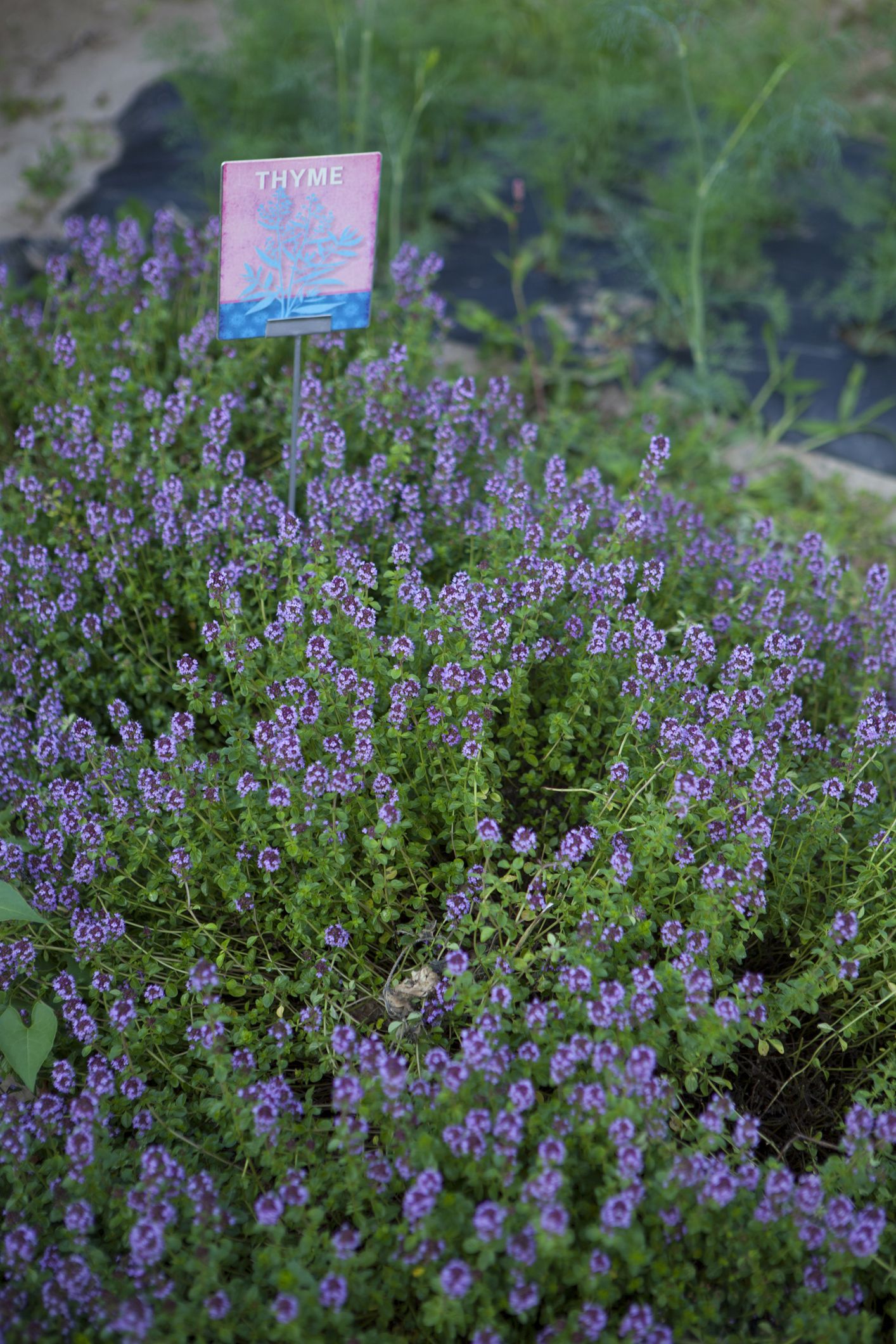

Use straw or other lightweight mulch to avoid smothering the plants. Add mulch around the plants to protect thyme from freezing in the winter.To revive them, divide the plants by dividing the roots. After a few years, thyme plants can become woody and straggly.A good time to prune is in the spring before it starts growing and after it flowers in summer. Pruning thyme will encourage more vigorous growth.Thyme will grow well with rosemary, sage, and other herbs with similar growing needs.In the second year, thyme needs less water and will become drought-tolerant. Thyme has low water needs but will need regular watering for the first year until the roots become established.Ten inches is preferred but one plant per square foot is optimal. Giving it rich organic soil will result in good growth, but it will have less fragrance. Thyme plants should be planted no closer than 8 inches apart. Like other Mediterranean herbs, thyme thrives on benign neglect. Thyme grows best in slightly sandy soil that drains quickly.At its highest, it will get about 1 foot tall. Choose a sunny location where the plants will have direct sunlight for 6 hours a day.Once the plants are ready, and all danger of frost is passed, you can start hardening off thyme seedlings to get ready for transplanting outdoors.Once the seedlings are 3 to 4 inches tall, you can cut off the tips to encourage the growth of side branches. To ensure your thyme seedlings are ready for outdoor life, give them time to become sturdy.Thyme leaves can also be dried by spreading them on a cookie sheet for a day or so in a warm dry area. The stems can be stewed in stock to release their flavor but remember to strain them out. Pick off the leaves or simply run your thumb and index finger down the length of the stem to push off the leaves.Ĭhop the leaves or add them whole to sauces, soups and other dishes. You can start using your thyme as soon as the plant has plenty of foliage. Growing thyme indoors allows you to have a constant ready supply of fresh seasoning. Begin by exposing the potted thyme to a semi-shade location to acclimate it to outdoor light and temperatures. Thyme growing indoors will benefit from relocation to the outdoors in summer. Thyme plants divide easily when repotted to reproduce even more plants. You’ll know it’s time when the roots are growing out of the bottom of the container. Potted Thyme CareĬontainer grown thyme needs to be repotted every season or two depending on the size of the pot and rate of growth. Removal of flowers increases foliage production. Trim off flowers and dry them for a sachet or use them in tea. Water completely each time but allow the pot to dry before watering again.įertilize thyme with a weak solution of fish emulsion or liquid seaweed, diluted by half every two weeks.Ĭut back overly woody stems on the thyme plant to force fresh new growth. Herb care for plants indoors is much the same as for those outdoors. Growing thyme inside will require temperatures in the daytime around 60 F. Once the thyme has been planted, place the container in a southern- or western-facing window if possible. The best results will be found when thyme is planted where it receives six hours of daylight. Thyme can tolerate indirect light, which makes it perfect for the kitchen herb garden. The container should have at least one large drainage hole.Ī good mix of sand, potting soil, peat moss and perlite will provide adequate nutrients and drainage. Other types of pots will suffice, but a clay pot will allow the thyme herb to dry out between watering and prevent overly wet roots as thyme isn’t tolerant of soggy root conditions.
#GROWING THYME FULL#
Thyme thrives in full sun, so plant them in a very sunny area. Space the seedlings 8 to 12 inches (20 to 30 centimeters) apart. 2 For best results, plant them in soil that is about 70F (21C). An excellent container for growing thyme is a clay planter. Plant your thyme seedlings in spring about two to three weeks before the last frost. Thyme is both a culinary and aromatic herb. Growing thyme inside is one of the easiest indoor herbs to cultivate. Growing thyme indoors requires plenty of sunshine and well drained soil. It adds a delicate aroma and almost grassy spice to any dish. What could be better than having the scents and flavors near at hand in the kitchen? Thyme ( Thymus vulgaris) is a useful herb that can be used in a variety of ways. Soil: Free-Draining Mix Plant Food: At the start: Balanced Blend. You’ll need: Thyme Planter: Ceramic Self Watering Planter or pot that is at least 6' / 1 quart. Fresh available herbs are a delight for the home cook. Below is the best setup (and a very easy one) for growing your thyme plants indoors.


 0 kommentar(er)
0 kommentar(er)
